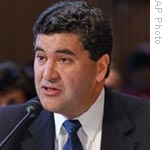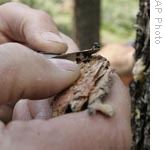VOA慢速英语 2008 1021b
时间:2019-01-11 作者:英语课 分类:VOA慢速英语2008(十)月
This is SCIENCE IN THE NEWS in VOA Special English. I'm Steve Ember.
VOICE TWO:
And I'm Barbara Klein. This week, we will tell about a plan to stop the disease malaria 1 in Africa by twenty fifteen. We will also tell about a change of leadership at America's National Institutes of Health. And we will tell about an insect suspected of influencing weather conditions in the Rocky Mountains.
(MUSIC)
VOICE ONE:
Governments, businesses and other groups have promised to add three billion dollars to the fight against malaria. The promises came last month at a meeting at the United Nations in New York.
The money will support a new Global Malaria Action Plan. The plan aims to stop the disease in Africa by two thousand fifteen. Malaria is not limited to Africa. Yet ninety percent of deaths happen south of the Sahara. British Prime Minister Gordon Brown says the plan will not only support bed nets, but research, cutting drug costs and expanding health care systems
VOICE TWO:
Governments and international groups spent a billion dollars on malaria programs last year. But the Roll Back Malaria Partnership 2 says the world should spend more than five times that amount. It says doing so could save four million lives by twenty-fifteen. The partnership includes U.N. agencies, the World Bank and leading drug makers 3.
Last month, the World Health Organization released its World Malaria Report for two thousand eight. The report presented sharply lower estimates of malaria cases than in the past. Officials say the corrections were mostly the result of better methods of collecting information.
VOICE ONE:
Until now, the W.H.O. has said there were as many as five hundred million infections every year, with a million deaths. The new report estimates the number of malaria cases in two thousand six at about two hundred fifty million. And, it estimates the number of deaths at eight hundred eighty-one thousand. The great majority who die are young children.
The W.H.O. says the old numbers came from using malaria maps from the nineteen sixties. But changes have taken place, including the movement of people to cities, especially in Asia. The disease is less common in cities and towns.
VOICE TWO:
The report says malaria deaths have decreased in several countries, and a few African nations have reduced deaths by half. Yet the malaria drugs needed for what is known as artemisinin-based combination therapy reached only three percent of African children in need.
In the last two years, there have been greatly increased efforts to provide families with bed nets. These nets are treated with insecticide products to kill the mosquitoes that spread malaria. Campaigns for indoor spraying of insecticides in homes have also increased in Africa and other areas.
(MUSIC)
VOICE ONE:

Elias Zerhouni
The director of the National Institutes of Health will resign at the end of this month. Doctor Elias Zerhouni has led the organization for more than six years.
The N.I.H. is the United States government's medical research agency. The research is done at its headquarters in Maryland, in other states and around the world. About eighteen thousand people work for the agency. It has twenty-seven centers and other institutes. They include the National Cancer Institute and the National Institute of Mental Health.
Doctor Zerhouni says he plans to write about his time at the N.I.H. before he accepts another position. During his first two years as director, the organization had strong financial support. But after that time, Congress did not increase the budget by very much.
VOICE TWO:
Some scientists have praised Doctor Zerhouni for creating a plan known as the N.I.H. Road Map.
The goal of the plan is to speed up creation of medical treatments and devices from scientific discoveries. This is to be done by getting researchers from different specialties 4 to cooperate.
In addition, Doctor Zerhouni is known for banning N.I.H. researchers from serving as paid consultants 5, or advisors 6, to drug manufacturers and chemical companies. Doctor Zerhouni announced the ban in two thousand five. He acted after lawmakers investigated scientists who also worked for private companies while still employed at the N.I.H. These employees received additional payment as consultants or members of boards of directors.
VOICE ONE:
Elias Zerhouni and his wife moved to the United States from Algeria in nineteen seventy-five. At the time, they had very little money and no family or friends in America. But he had completed medical school at the University of Algiers. He began his graduate school training as a doctor at John Hopkins University School of Medicine in Baltimore, Maryland.
Later, Doctor Zerhouni held increasingly important medical positions at the School. Before his appointment to the N.I.H., he was chief of radiology at the university's hospital. Radiology uses X rays and other methods to find and treat medical problems. Doctor Zerhouni also established or helped establish medical companies. One of the companies produced a device that lets magnetic resonance 7 imaging tests be done in places other than hospitals.
VOICE TWO:
President Bush chose Doctor Zerhouni to lead the N.I.H. eight years ago. The president made the appointment after limiting federal financing of research on stem cells from human embryos 8. Stem cells can grow into any one of the body's cells. Scientists say such cells have the possibility of treating diseases like cancer and Parkinson's disease. Last year, the doctor told the Congress he thought the limits were interfering 9 with progress in research.
Doctor Zerhouni said his resignation would let the new American President choose his own director of the N.I.H. The presidential election is two weeks from now.
(MUSIC)
VOICE ONE:

A mountain pine beetle 10 near Vail, Colorado
Finally, scientists are attempting to learn whether a tree-killing 11 insect can have an effect on weather conditions and air quality. The mountain pine beetle is a threat to forests in the western United States. The beetles 12 invade pine trees to mate and leave their eggs. A tree will produce a sticky substance in an effort to defend itself against the beetles.
In some cases, however, the insects are able to enter the tree. The beetle larvae 13 then feed off the tree as they develop under the tree's bark or protective cover. The larvae rob the tree of its nutrients 14 as they feed. It takes one year for the larvae to develop and become adult beetles. In that time, the tree is so weakened, that it dies.
VOICE TWO:
The mountain pine beetle has killed large numbers of pine trees. But that might not be the only effect of the insect. American scientists are leading an international project to study how the large tree kills affect weather conditions.
The scientists work at the National Center for Atmospheric 15 Research in Boulder 16, Colorado. The project is called BEACHON. That is short for Bio-hydro-atmosphere Interactions of Energy, Aerosols 17, Carbon, H-two-O, Organics and Nitrogen.
VOICE ONE:
Earlier studies have suggested that beetles killing trees can result in temporary increases in temperature. The scientists say this is partly because the lost trees do not throw the sun's heat back into space.
Scientists also believe that beetle attacks cause trees to release more particles and chemicals in the atmosphere as they fight the insects. This makes air quality worse and at least temporarily increases levels of ground-level ozone 18. This affects both nearby air quality and temperatures.
VOICE TWO:
The BEACHON project is expected to last four years. It will cover an area extending from southern Wyoming to northern New Mexico.
Scientists say they will use aircraft, instruments on the ground and above the trees to study relationships between Earth and its atmosphere. Scientists will be able to gather information about cloud formation, climate change and movement of gases and particles between the ground and the atmosphere. Plants release gases like water vapor 19 and tiny particles that influence the atmosphere. The scientists say the exchange of gases and particles between the ground and the atmosphere is especially important in dry areas such as the western United States.
(MUSIC)
VOICE ONE:
This SCIENCE IN THE NEWS program was written by Brianna Blake, Jerilyn Watson and Caty Weaver 20. Brianna Blake was also our producer. I'm Steve Ember.
VOICE TWO:
And I'm Barbara Klein. Read and listen to our programs at voaspecialenglish.com. Join us again at this time next week for more news about science in Special English on the Voice of America.
- He had frequent attacks of malaria.他常患疟疾。
- Malaria is a kind of serious malady.疟疾是一种严重的疾病。
- The company has gone into partnership with Swiss Bank Corporation.这家公司已经和瑞士银行公司建立合作关系。
- Martin has taken him into general partnership in his company.马丁已让他成为公司的普通合伙人。
- The makers of the product assured us that there had been no sacrifice of quality. 这一产品的制造商向我们保证说他们没有牺牲质量。
- The makers are about to launch out a new product. 制造商们马上要生产一种新产品。 来自《简明英汉词典》
- Great Books are popular, not pedantic. They are not written by specialists about specialties for specialists. 名著绝不引经据典,艰深难懂,而是通俗易读。它们不是专家为专业人员撰写的专业书籍。 来自英汉 - 翻译样例 - 文学
- Brain drains may represent a substantial reduction in some labor force skills and specialties. 智力外流可能表示某种劳动力技能和特长大量减少。 来自辞典例句
- a firm of management consultants 管理咨询公司
- There're many consultants in hospital. 医院里有很多会诊医生。
- The governors felt that they were being strung along by their advisors. 地方长官感到他们一直在受顾问们的愚弄。 来自《现代汉英综合大词典》
- We will consult together with advisors about her education. 我们将一起和专家商议她的教育事宜。 来自互联网
- Playing the piano sets up resonance in those glass ornaments.一弹钢琴那些玻璃饰物就会产生共振。
- The areas under the two resonance envelopes are unequal.两个共振峰下面的面积是不相等的。
- Somatic cells of angiosperms enter a regenerative phase and behave like embryos. 被子植物体细胞进入一个生殖阶段,而且其行为象胚。 来自辞典例句
- Evolution can explain why human embryos look like gilled fishes. 进化论能够解释为什么人类的胚胎看起来象除去了内脏的鱼一样。 来自辞典例句
- A firefly is a type of beetle.萤火虫是一种甲虫。
- He saw a shiny green beetle on a leaf.我看见树叶上有一只闪闪发光的绿色甲虫。
- Investors are set to make a killing from the sell-off.投资者准备清仓以便大赚一笔。
- Last week my brother made a killing on Wall Street.上个周我兄弟在华尔街赚了一大笔。
- Beetles bury pellets of dung and lay their eggs within them. 甲壳虫把粪粒埋起来,然后在里面产卵。 来自《简明英汉词典》
- This kind of beetles have hard shell. 这类甲虫有坚硬的外壳。 来自《现代汉英综合大词典》
- Larvae are parasitic on sheep.幼虫寄生在绵羊的身上。
- The larvae prey upon small aphids.这种幼虫以小蚜虫为食。
- a lack of essential nutrients 基本营养的缺乏
- Nutrients are absorbed into the bloodstream. 营养素被吸收进血液。 来自《简明英汉词典》
- Sea surface temperatures and atmospheric circulation are strongly coupled.海洋表面温度与大气环流是密切相关的。
- Clouds return radiant energy to the surface primarily via the atmospheric window.云主要通过大气窗区向地表辐射能量。
- We all heaved together and removed the boulder.大家一齐用劲,把大石头搬开了。
- He stepped clear of the boulder.他从大石头后面走了出来。
- Aerosols are present throughout the atmosphere. 气溶胶存在于整个大气层。 来自辞典例句
- Deodorants are available as aerosols or roll-ons. 除臭剂有喷雾装或滚抹装。 来自辞典例句
- The ozone layer is a protective layer around the planet Earth.臭氧层是地球的保护层。
- The capacity of ozone can adjust according of requirement.臭氧的产量可根据需要或调节。
- The cold wind condenses vapor into rain.冷风使水蒸气凝结成雨。
- This new machine sometimes transpires a lot of hot vapor.这部机器有时排出大量的热气。